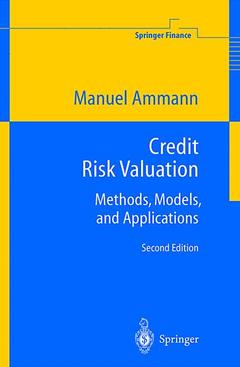Description
Credit Risk Valuation (2nd Ed., 2nd ed. 2001)
Methods, Models, and Applications
Springer Finance Series
Language: English
Subjects for Credit Risk Valuation:
Credit Risk Valuation (2nd Ed.)
Publication date: 12-2010
255 p. · 15.5x23.5 cm · Paperback
Publication date: 12-2010
255 p. · 15.5x23.5 cm · Paperback
Credit Risk Valuation : Methods, Models, and Applications (2nd Ed. 2001, corr. 2nd printing 2002)
Publication date: 06-2001
255 p. · 15.6x23.4 cm · Hardback
Publication date: 06-2001
255 p. · 15.6x23.4 cm · Hardback
Description
/li>Contents
/li>Comment
/li>
Credit risk is an important consideration in most financial transactions. As for any other risk, the risk taker requires compensation for the undiversifiable part of the risk taken. In bond markets, for example, riskier issues have to promise a higher yield to attract investors. But how much higher a yield? Using methods from contingent claims analysis, credit risk valuation models attempt to put a price on credit risk. This monograph gives an overview of the current methods for the valu ation of credit risk and considers several applications of credit risk models in the context of derivative pricing. In particular, credit risk models are in corporated into the pricing of derivative contracts that are subject to credit risk. Credit risk can affect prices of derivatives in a variety of ways. First, financial derivatives can be subject to counterparty default risk. Second, a derivative can be written on a security which is subject to credit risk, such as a corporate bond. Third, the credit risk itself can be the underlying vari able of a derivative instrument. In this case, the instrument is called a credit derivative. Fourth, credit derivatives may themselves be exposed to counter party risk. This text addresses all of those valuation problems but focuses on counterparty risk. The book is divided into six chapters and an appendix. Chapter 1 gives a brief introduction into credit risk and motivates the use of credit risk models in contingent claims pricing.
1. Introduction.- 2. Contingent Claim Valuation.- 3. Credit Risk Models.- 4. A Firm Value Pricing Model for Derivatives with Counterparty Default Risk.- 5. A Hybrid Pricing Model for Contingent Claims with Credit Risk.- 6. Pricing Credit Derivatives.- 7. Conclusion.- A. Useful Tools from Martingale Theory.- A.1 Probabilistic Foundations.- A.2 Process Classes.- A.3 Martingales.- A.4 Brownian Motion.- A.5 Stochastic Integration.- A.6 Change of Measure.- References.- List of Figures.- List of Tables.
Includes supplementary material: sn.pub/extras
© 2024 LAVOISIER S.A.S.




